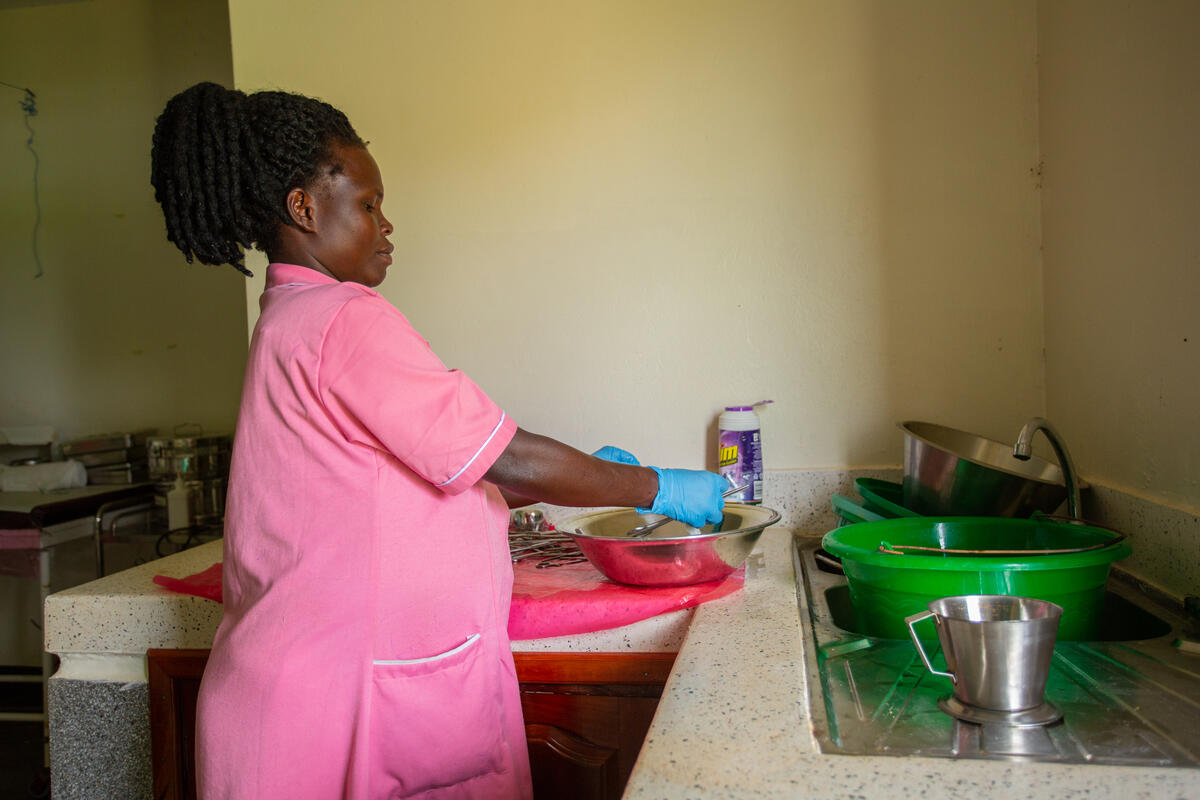Creating a realistic investment pathway for WASH in health care facilities. It's all about "manageable portions" and reaching the politicians.
Published on: 18/04/2024

Delivery room work station improved with Terrazzo and running water for infection control and prevention. Photo credit: Amref
New research from WaterAid published on April 7th, World Health Day, presented some shocking figures on the high cost of preventable health care infections in seven sub-Saharan African countries including Uganda.
WaterAid’s research estimated that in Uganda in 2022 there were some 422,000 cases of hospital-acquired infections (HAIs) compounded by rising antimicrobial resistance (AMR), which led to 43,600 excess deaths. Lost wages and productivity due to infections, lives lost, and the medical costs of treating HAIs cost the country an estimated US$ 580 million in economic costs, which equates with 1.43% of its Gross Domestic Product (GDP). The financial costs of providing health care to treat HAIs was US$ 123 million in 2022, or 7.9% of total health expenditure.
The good news is that at least half of HAIs can be prevented by basic WASH services, waste management and environmental cleaning, saving 21,800 lives and US$ 290 million of GDP and health expenditure. The cost of providing these services is estimated at less than US$ 1 per capita, which would more than cover the savings in medical costs of US$ 1.40 per capita per year.
When confronted with WaterAid’s research findings, IRC Uganda’s Martin Watsisi wondered which data they had based their research on. It turned out that WaterAid had used the methodology developed by the World Bank for its desk study on the costs of HAIs in nine countries in Eastern and Southern Africa, which also included Uganda. The methodology relies on secondary data sources, including meta-analyses and individual studies. Martin thinks that the true economic and social costs of HAIs are likely to be higher because several impacts couldn’t be included due to a lack of data and a lack of methods to quantify them in US dollars.
Uganda is among the 24% of countries (n=118) that have an approved costed plan for WASH in health care facilities (HCF), a statistic mentioned in the 2023 WHO/UNICEF global report on WASH in health care facilities. The global report has another, more sobering statistic: only 3% of 118 surveyed countries have sufficient financial and human resources to implement their costed plan.
In 2018, IRC Uganda supported the development of a costed household WASH master plan for Kabarole district for 2018-2030. This 2018 version of the master plan includes targets for WASH in HCF (fig. 1), but these were not costed. This did happen in 2022, when the Ministry of Health, with support from UNICEF and WaterAid, published a National Micro Planning Handbook for WASH in HCF for all districts in Uganda. For Kabarole the funding gap for WASH in HCF was calculated to be US$ 2.18 million (fig. 2). This may seem a modest investment for Kabarole’s 47 HCFs until Martin informs you that the annual budget of a typical Health Centre III (HCIII) which serves 10,000 people is US$ 6,400.
So, what is a realistic investment pathway? Martin suggests taking an incremental service level approach to funding the five domains of WASH in HCF (see fig. 3) and by breaking investment into “manageable portions”. Another option is to focus on specific areas such as maternal and infant health, where investing in WASH is especially important. Implementing the guidelines to spend around 30% of Primary Health Care (PHC) grants for WASH in HCF will also help.
Nevertheless, you still need to advocate for more WASH in HCF funding. The data from the 2024 WaterAid study could help advocacy efforts. Stricter enforcement of WASH in HCF byelaws, might work for the private health sector whose licences can be revoked, says Martin, but not when the government is both a health service provider and enforcer of the law.
Uganda has established a 15-person national steering committee for WASH in HCF. Members include ministries and development partners, and IRC Uganda gets consulted. However, the committee is not the budget holder for WASH in HCF. You would need to go a step higher to influence parliamentarians or even the ministerial cabinet level.
Returning to the WaterAid report, Martin is concerned about how “negative” headlines around the statistics will resonate with government, which is already confronted with rampant corruption and criticism of its oversized and overpaid parliament. The government would prefer to hear how much GDP can grow and how many lives can be saved. The ultimate goal of WASH is better health, said Martin, and health is the basis for GDP growth.
What is needed, says Martin, is to break the WaterAid report down into key messages and propose simple actions as input for some form of national stakeholder engagement with budget holders. They need to convince the politicians.
Acknowledgements: This blog was compiled by Cor Dietvorst based on an interview with Martin Watsisi. It was review by John Butterworth and copy-edited by Tettje van Daalen.
At IRC we have strong opinions and we value honest and frank discussion, so you won't be surprised to hear that not all the opinions on this site represent our official policy.